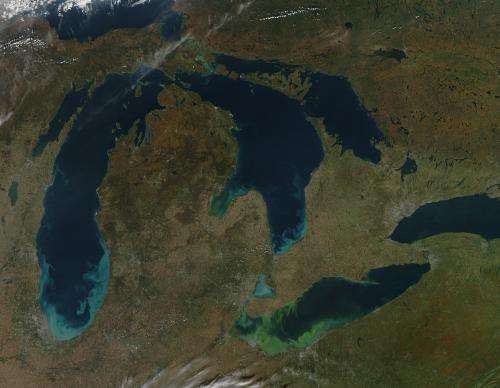Climate change, algal blooms and 'dead zones' in the Great Lakes

(Phys.org)—Climate change is expected to increase the frequency of intense spring rain storms in the Great Lakes region throughout this century and will likely add to the number of harmful algal blooms and "dead zones" in Lake Erie, unless additional conservation actions are taken, according to a University of Michigan aquatic ecologist.
Climate models suggest that the number of intense spring rain storms in the region could double by the end of the century, contributing to an overall 30 to 40 percent increase in spring precipitation, said Donald Scavia, director of the U-M's Graham Sustainability Institute.
That increase, combined with the greater availability of phosphorous due to current agricultural practices in the Midwest, means that increased amounts of the nutrient will be scoured from farmlands and run into rivers that feed Lake Erie, fueling algae blooms and low-oxygen zones known as dead zones.
"Climate change is likely to make reducing phosphorous loads even more difficult in the future than it is now, which will likely lead to even more toxic algae blooms and larger dead zones unless more conservation is undertaken," said Scavia, who will present his latest findings on the topic Wednesday morning during Great Lakes Week events in Cleveland.
"Current agricultural practices and climate are conspiring to increase the phosphorous loads that make their way into Lake Erie," said Scavia, a professor at the U-M School of Natural Resources and Environment.
The agricultural practices that contribute to increased availability of phosphorous from fertilizer include no-till farming, a method of planting crops without plowing. The technique reduces soil erosion but also leaves "high concentrations of phosphorous in the upper surface soil, and these intense storms appear to be flushing it out," Scavia said.
The widespread adoption of no-till farming and other agricultural techniques since the mid-1990s have had some positive effects but appear to have also increased the availability of the type of phosphorous, known as soluble reactive phosphorous, that promotes algae blooms, Scavia said.
Since the mid-1990s, intense spring rain storms have also become more common in the Great Lakes region, especially in southeast Michigan and northwest Ohio, the regions that provide runoff into Lake Erie, Scavia said.
Current agricultural best management practices – such as planting buffer strips around cropland, protecting wetlands and using less fertilizer – applied at the current scales are likely "not going to be sufficient to reduce the phosphorous loads to the levels we need to prevent the blooms and to get rid of the dead zones," Scavia said.
In the late 1960s, 1970s and early 1980s, control strategies focused on reducing phosphorous from specific sources, such as waste-treatment plants. Reductions from those so-called point sources led to major gains in Great Lakes health, including a drop in the frequency and extent of harmful algae blooms and dead zones.
Some of those gains have been reversed since the mid-1990s. The increased availability of soluble reactive phosphorous and a surge in extreme rainfall events in the region have contributed to a resurgence of both harmful algal blooms and dead zones in Lake Erie, Scavia said.
Algae blooms can foul harbors, clog boat motors, reduce fish populations, and can sometimes be toxic to humans. Dead zones are low-oxygen regions where most aquatic organisms cannot survive.
Provided by University of Michigan
















